
The Chicago "L" is the rapid transit system serving the city of Chicago and some of its surrounding suburbs in the U.S. state of Illinois. Operated by the Chicago Transit Authority (CTA), it is the fourth-largest rapid transit system in the United States in terms of total route length, at 102.8 miles (165.4 km) long as of 2014, and the third-busiest rapid transit system in the United States. In 2016, the "L" had 1,492 rail cars, eight different routes, and 145 train stations. In 2023, the system had 117,447,000 rides, or about 373,800 per weekday in the fourth quarter of 2023.
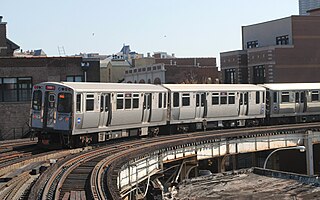
The Red Line is a rapid transit line in Chicago, run by the Chicago Transit Authority (CTA) as part of the Chicago "L" system. It is the busiest line on the "L" system, with an average of 93,457 passengers boarding each weekday in 2022. The route is 26 miles (42 km) long with a total of 33 stations. It runs elevated from the Howard station in the Rogers Park neighborhood on the North Side, through a subway on the Near North Side, Downtown, and the South Loop, and then through the Dan Ryan Expressway median to 95th/Dan Ryan in the Roseland neighborhood on the South Side.

95th/Dan Ryan, announced as 95th, is an 'L' station in the median of the Dan Ryan Expressway and serving Chicago's Roseland neighborhood. It serves as the southern terminus of the Chicago Transit Authority's Red Line. This station was the system's thirteenth busiest in 2021. Trains take approximately 30 minutes to travel to the Loop, and 60 minutes to reach Howard.
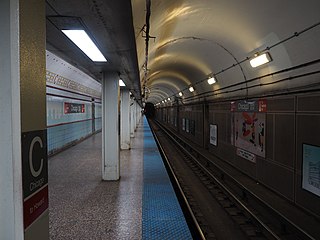
Chicago, is an "L" station on the CTA's Red Line. It serves a significant portion of the Near North Side and Streeterville neighborhoods. With over 5.25 million overall boardings in 2014, it is the busiest station on the Red Line north of the Loop.

Garfield is an "L" station on the CTA's Green Line. It is situated at 320 E. Garfield Boulevard in the Washington Park neighborhood. It opened on October 12, 1892. This station is the southernmost Green Line station served by both of the Green Line's branches: south of Garfield, the Green Line splits into two branches, one terminating at Ashland/63rd, and one at Cottage Grove.

Sox–35th is an 'L' station on the CTA's Red Line. It is situated at 142 West 35th Street in the Armour Square neighborhood. The station opened on September 28, 1969, along with the other eight stations on the Dan Ryan branch.

Kedzie is a station on the Chicago Transit Authority's 'L' system, serving the Green Line and the East Garfield Park neighborhood. It opened in March 1894, and is three blocks south of Metra's Kedzie station on the Union Pacific West Line. It is also near the Chicago Center for Green Technology.
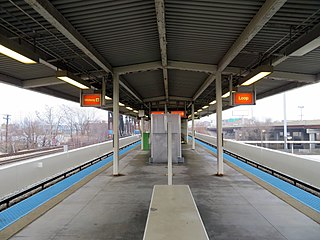
Ashland is a station on the Chicago Transit Authority's 'L' system, serving the Orange Line. It is located at the intersection of Ashland Avenue and 31st Street near the Stevenson Expressway. Although located within the Lower West Side community area, the station mostly serves the Bridgeport and McKinley Park neighborhoods.

Garfield is an "L" station on the CTA's Red Line. The station is located in the median of the Dan Ryan Expressway. It is located in the Fuller Park neighborhood. This is the Red Line's closest stop to the University of Chicago and the Museum of Science and Industry, although the museum is more than two miles away. The station shares its name with its Green Line equivalent.

63rd is a station on the Chicago Transit Authority's 'L' system, serving the Red Line. The station is located in the median of the Dan Ryan Expressway and serves the Englewood neighborhood. It is near the former site of the Englewood Union Station, which served the Pennsylvania Railroad, New York Central, and Rock Island Lines. The former Pennsylvania Railroad tracks pass over the station. Also visible from the station is the Ashland branch of the Green Line which runs on an elevated structure immediately west of the expressway at the location before turning west on 63rd Street.

69th is a station on the Chicago Transit Authority's 'L' system, serving the Red Line. The station is located in the median of the Dan Ryan Expressway, within the Greater Grand Crossing neighborhood. This station connects with the second most bus routes on the Dan Ryan Branch, and is one of the terminals for the N5 South Shore Night Bus. This makes it an important connection for buses, especially Night Owl connections.

79th is a station on the Chicago Transit Authority's 'L' system, serving the Dan Ryan branch of the Red Line. The station is located in the median of the Dan Ryan Expressway. It was the first station on the Dan Ryan branch to feature an elevator for accessibility. The station's location is between the Greater Grand Crossing and Chatham neighborhoods.
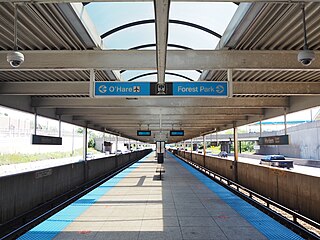
Harlem is a Chicago "L" station serving the Blue Line's O'Hare branch in Chicago's Norwood Park neighborhood. It is not to be confused with the other Harlem Blue Line station. Trains run from Harlem every 2–7 minutes during rush hour, and take 30–45 minutes to travel to the Loop. O'Hare-bound trains take 10 minutes to reach the airport from Harlem. The station is located in the median of the Kennedy Expressway.

Irving Park is an 'L' station on the CTA's Blue Line. The station is located in the median of the Kennedy Expressway in the Irving Park neighborhood, though it draws its name from its cross street. Irving Park is one of two stations on the Blue Line that stops in an expressway median where the entrance is below the platform; Rosemont is the other, specifically beneath the westbound lane of the Kennedy Expressway. The station opened in 1970 as a part of the Kennedy extension of the Milwaukee Elevated from Logan Square to Jefferson Park.

Cermak Road, also known as 22nd Street, is a 19-mile, major east–west street on Chicago's near south and west sides and the city's western suburbs. In Chicago's street numbering system, Cermak is 2200 south, or twenty-two blocks south of the baseline of Madison Street. Normally, one mile comprises eight Chicago blocks, but the arterial streets Roosevelt Road, formerly named Twelfth Street and at 1200 South, and Cermak Road were platted before the eight-blocks-per-mile plan was implemented. Roosevelt Road is one mile south of Madison Avenue and there are twelve blocks within that mile. Cermak Road is two miles south of Madison Avenue and there are ten blocks within the mile between Roosevelt and Cermak Roads.

Cermak–McCormick Place is a "L" station on the CTA's Green Line. The station, designed by Chicago-based Ross Barney Architects and engineered by Primary Consultant T.Y. Lin International, is located at Cermak Road and State Street in the Near South Side neighborhood of Chicago. The station includes three entrances – one on each side of Cermak Road and one at 23rd Street. The main station entrance is built on the north side of Cermak road.
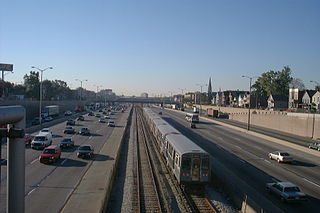
The Dan Ryan branch is a 9.4 mi (15.1 km) long section of the Chicago "L" system located on the South Side of Chicago, Illinois. It is operated by the Chicago Transit Authority, as part of its Red Line service and is normally through-routed downtown towards the North Side via the State Street subway. As of February 2013, the branch serves 45,355 passengers per weekday. As part of the CTA's busiest rapid transit line, it is operated 24 hours a day, 365 days a year. The branch serves the Chinatown, Armour Square, Fuller Park, Englewood, Greater Grand Crossing, Chatham and Roseland neighborhoods.
The Lake–Dan Ryan Line was a rail rapid transit route formerly operated by the Chicago Transit Authority (CTA). The Lake–Dan Ryan Line existed from the opening of the Dan Ryan branch on September 28, 1969, until February 21, 1993. When created, the route united two transit corridors that until 1969 never had through rail service. This routing, which became known as the West-South route, operated from the Harlem terminal in Forest Park on the Lake Street "L" through downtown Chicago along the Union Loop "L", and then via the old South Side "L" and the new Dan Ryan Line to the 95th Street Terminal. The Lake–Dan Ryan service was planned in conjunction with the former Franklin Street Connector and Chicago Central Area Transit Project, both of which were never constructed. The section of the route between the junction with the South Side "L" at 17th and State Streets and the Cermak–Chinatown Station was originally an "interim", or temporary facility. It was planned to be torn down when the Loop Subway system was completed, but survived after the project was canceled in 1979. That section was improved in the 1980s and early 1990s and is currently being used by the Orange Line. Train transfers are possible by using the two unused tracks.

Roosevelt is an "L" station on the CTA's Red, Green, and Orange Lines, located between the Chicago Loop and the Near South Side in Chicago, Illinois. It is situated at 1167 S State Street, just north of Roosevelt Road. The station is also the closest "L" station to the Museum Campus of Chicago and Soldier Field, which are about 1⁄2 mile (800 m) to the east. The Museum Campus/11th Street Metra station is also about 1⁄3 mile (500 m) to the east.
In the spring of 2012, Chicago Transit Authority started a station and track rehabilitation program dubbed "Red Ahead", beginning on the North Side Main Line, which is called the "Red North" project. The program monitors the full route of the Red Line, which does not include the stations of Loyola, Bryn Mawr, Sheridan, or Wilson. Stations between Wilson through Fullerton, and the State Street subway, are also not included. In May 2012, the CTA started to work on the North Side Main Line stations which includes Jarvis, Morse, Granville, Thorndale, Berwyn, Argyle, and Lawrence. The stations are listed in order, starting at Granville, then Morse, Thorndale, Argyle, Berwyn, Lawrence, and finally Jarvis. This project started in June 2012 and completed in December 2012. This project is also part of the Red Ahead's "Red & Purple Modernization" project.




















